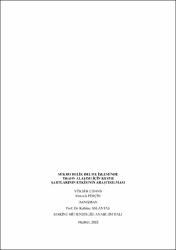| dc.contributor.advisor | Aslantaş, Kubilay | |
| dc.contributor.author | Perçin, Mustafa | |
| dc.date.accessioned | 2019-05-22T14:18:29Z | |
| dc.date.available | 2019-05-22T14:18:29Z | |
| dc.date.issued | 2015 | |
| dc.identifier.uri | http://hdl.handle.net/11630/6080 | |
| dc.description | In this study, the size of burrs occurring in the hole after drilling operations conducted in different conditions of cooling and cutting, hole surface roughness, cutting force and torque 's changes are investigated in detail. For this purpose, especially in the aerospace and biomedical sectors commonly used Ti-6Al-4V material is chosen as the workpiece. The four different cooling methods used in this study, the amount of burr holes occurring in the input and output were determined by 3D profilometer. Also the cooling process influence the surface quality of the hole and the tool damage occurring in the types have been identified. Obtained results; the cooling techniques used in the micro drilling operation, to reduce the burr, showed to have a significant not effect. But to say that the cryogenic cutting burrs less than the amount obtained as a result. The tool wear of the used cooling method would not be wrong to say that significant influence. Flooded, and in particular oil drilling holes with MQL significant change has occurred in the tool diameter. But dry cutting and wear occurring on the team in cryogenic drilling operation has been found to occur as a result of the more abrasive wear mechanism. | en_US |
| dc.description.abstract | Bu çalışmada, farklı kesme ve soğutma koşullarında yapılan delik delme işleminde delik sonrasında meydana gelen çapak boyutu, delik yüzey kalitesi, delme işlemi boyunca oluşan kuvvet ve tork’ un değişimi detaylı olarak araştırılmıştır. Bu amaçla özellikle havacılık ve biyomedikal sektöründe sıklıkla kullanılan Ti-6Al-4V malzemesi iş parçası olarak seçilmiştir. Çalışmada dört farklı soğutma yöntemi kullanılmış olup, delik giriş ve çıkışlarında meydana gelen çapak oluşumları 3D profilometre cihazı ile tespit edilmiştir. Ayrıca soğutma yönteminin delik yüzey kalitesi üzerindeki etkisi ve takımda meydana gelen hasar tipleri belirlenmiştir. Elde edilen sonuçlar; mikro delik delme işleminde kullanılan soğutma yönteminin, çapağın azaltılmasında, önemli bir etkiye sahip olmadığı görülmüştür. Buna karşılık kriyojenik soğutmanın, meydana gelen çapak oluşumunu azalttığı söylenebilir. Bununla birlikte, kullanılan soğutma yönteminin takım aşınması üzerinde önemli bir etkisi olduğu görülmüştür. Özellikle bor yağı ve MQL ile yapılan delik delme işlemlerinde takım aşınmasına bağlı takım çapı küçülmesi minimum seviyede, fakat kuru kesme ve kriyojenik delik delme işlemlerinde takımda meydan gelen çap küçülmesinin daha fazla olduğu tespit edilmiştir. Aşınmaya bağlı olarak oluşan bu çap azalması abrasiv aşınma mekanizmasının bir sonucu olarak gerçekleşmiştir. | en_US |
| dc.language.iso | tur | en_US |
| dc.rights | info:eu-repo/semantics/openAccess | en_US |
| dc.subject | Mikro delik delme 1, Ti-6Al-4V 2, Minimal miktar yağlama 3, Kriyojenik soğutma 4, Kesme kuvvetleri 5 | en_US |
| dc.title | Mikro Delik Delme İşleminde Ti6al4v Alaşımı için Kesme Şartlarının Etkisinin Araştırılması | en_US |
| dc.title.alternative | Mıcro Drıllıng Operatıon for Ti6al4v Alloy to Investıgate the Effects of Cuttıng Condıtıons | en_US |
| dc.type | masterThesis | en_US |
| dc.department | Fen Bilimleri Enstitüsü | en_US |
| dc.identifier.startpage | 1 | en_US |
| dc.identifier.endpage | 65 | en_US |
| dc.relation.publicationcategory | Tez | en_US |



















